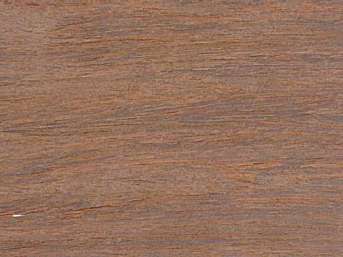
Alcornoque (Bowdichia nitida)
Family: Leguminosae
Common names: Alcornoque, Black sucupira, Black supupira, Hudoke, Maarachyba, Sapupira, Sapupira da mata, Sebipira, Sucupira, Sucupira amarella, Sucupira mata
Distributed in: Brazil (Latin America)
Common uses: Boat building (general), Boat building: decking, Boat building: framing, Cabinetmaking, Door, Flooring, Furniture, Heavy construction, Joinery, Light construction, Musical instruments: piano, Poles, Railroad ties, Structural work, Turnery, Vehicle parts, Veneer: decorative, Wheels
Product sources: The ITTO reports that an occasional source for timber production in Ivory Coast, Gabon, Congo, Mozambique, and Tanzania.
Environment profile: Abundant/Secure
Tree size: Trunk diameter is 150-200 cm
Colors: the heart isYellow, Yellow to golden-yellow to orangeand the sapwoodWhite to yellow, Yellow.The grain isWavy, the textureMedium coarse to coarseand the lusterMedium
Natural durability: Resistant to attack from termites (Isoptera), Very durable
Kiln Schedules: Kiln Drying Rate (in days) is rapid
Kiln Drying Rate: Fairly rapid (11-17 days for boards under 32 mm, to 31-51 days for boards greater than 63 mm)
Drying Defects: Severe cupping, Severe surface checking
Ease of Drying: Slowly
Tree Identification: Bole/stem form is straight
Comments: General finishing qualities are rated as good General finishing qualities are rated as satisfactory
Blunting Effect: Moderate
Boring: Fairly easy to very easy
Carving: Fairly Easy to Very Easy
Cutting Resistance: Easy to saw
Gluing: Very Good to Excellent Results
Mortising: Fairly Easy to Very Easy
Moulding: Fairly Easy to Very Easy
Movement in Service: Fairly Easy to Very Easy
Nailing: Fairly Easy to Very Easy, Very Good to Excellent
Planing: Fairly Easy to Very Easy
Resistance to Impregnation: Resistant sapwood
Response to hand tools: Moderate working qualities
Routing recessing: Fairly Easy to Very Easy
Sanding: Fair to Good Results
Steam bending: Fair to Good Results
Screwing: Fair to Good Results, Very Good to Excellent Results; Turning: Fairly Easy to Very Easy
Painting: Good; Polishing: Very Good to Excellent; Staining: Fairly Easy to Very Easy; Varnishing: Fairly Easy to Very Easy;
- Numerical data Metric
- Numerical data English
- Strength properties
- References
 |
 |
 |
 |
| Item |
Green |
Dry |
Metric |
| Specific Gravity |
|
|
|
| Density |
|
993 |
kg/m3 |
| Bending Strength |
1008 |
1507 |
kg/cm2 |
| Crushing Strength |
485 |
699 |
kg/cm2 |
| Hardness |
|
|
kg |
| Impact Strength |
|
|
cm |
| Shearing Strength |
|
|
kg/cm2 |
| Stiffness |
|
|
1000 kg/cm2 |
| Tangential Shrinkage |
7 |
|
% |
| Radial Shrinkage |
4 |
|
% |
| Weight |
977 |
801 |
kg/m3 |
| Maximum Load |
|
|
cm-kg/cm3 |
| Toughness |
|
|
cm-kg |
| Static Bending |
|
|
kg/cm2 |
|
 |  |  |  | | Item | Green | Dry | English | | Bending Strength | 14342 | 21437 | psi | | Density | | 62 | lbs/ft3 | | Maximum Crushing Strength | 6899 | 9945 | psi | | Weight | 61 | 50 | lbs/ft3 | | Radial Shrinkage | 4 | | % | | Tangential Shrinkage | 7 | | % | | Volumetric Shrinkage | 11 | | % | |
Density (dry weight) = 61-67 lbs/cu.ft.
Bending strength (MOR) = high
Shrinkage, Volumetric = moderate
Shrinkage, Tangential = moderate
Shrinkage, Radial = moderate
Max. crushing strength = high
Bending strength (MOR) = very high
Bending strength (MOR) = medium
Brazil -, I.B.D.F.,1980,Woods from Tucurui - characteristics and application,The Ag. Ministry Brazilian Institute for Forest DevelopmentBrown, W.H.,1978,Timbers of the World, No. 2 South America,TRADA, Red Booklet SeriesErfurth, T., Rusche, H.,1976,The Marketing of Tropical Wood B. Wood Species from S. American Tropical,Moist Forests,F.A.O. Forestry DepartmentFarmer, R.H.,1972,Handbook of Hardwoods,HMSOHoward, A.L.,1948,A Manual of Timbers of the World.,Macmillan & Co. Ltd. London 3rd ed.Mainieri, C., Pereira, J.A.,1965,Madeiras do Brasil,Anuario Brasileiro de Economia Florestal,17(17,PP135-416Record, S.J., Hess, R.W.,1943,Timbers of the New World,Yale University PressRecord, S.J., Mell, C.D.,1924,Timbers of Tropical America,Yale Univ. PressRecord, S.J.,1931,Notes on Brazilian Timbers Hudoke and Macawood,Tropical Woods,4(27,pp14-5Rendle, B.J.,1969,World Timbers (3 Vols.,Ernest Benn Ltd. LondonRizzini, C.T.,1978,Arvores e Madeiras Uteis do Brasil: Manual de Dendrologia Brasileira,Editora Edgard Blucher LTDA BrazilWoods, R.P.,1949,Timbers of South America,TRADA, Red Booklet SeriesWood, B., Calnan, D.,1976,Toxic Woods,British Journal of Dermat 94 Suppl. 13
|








